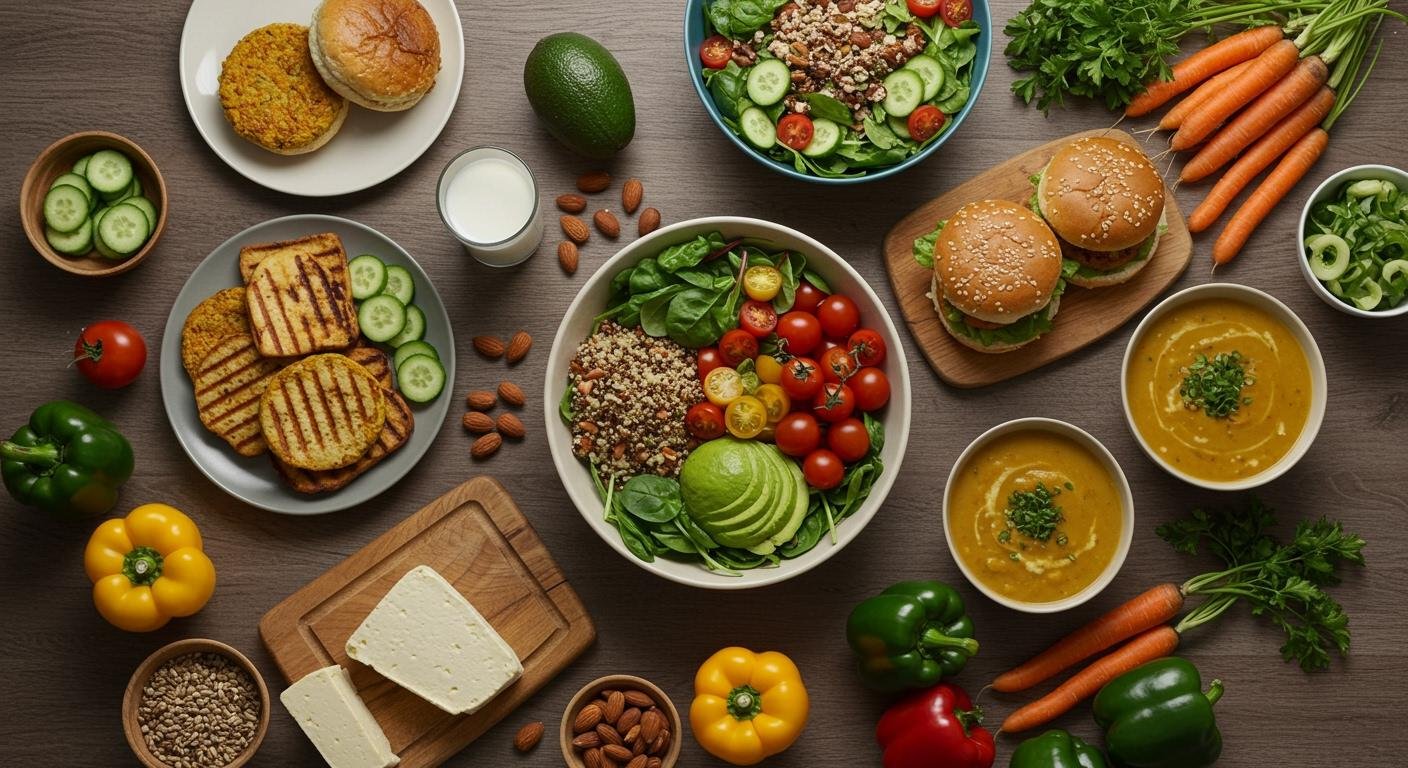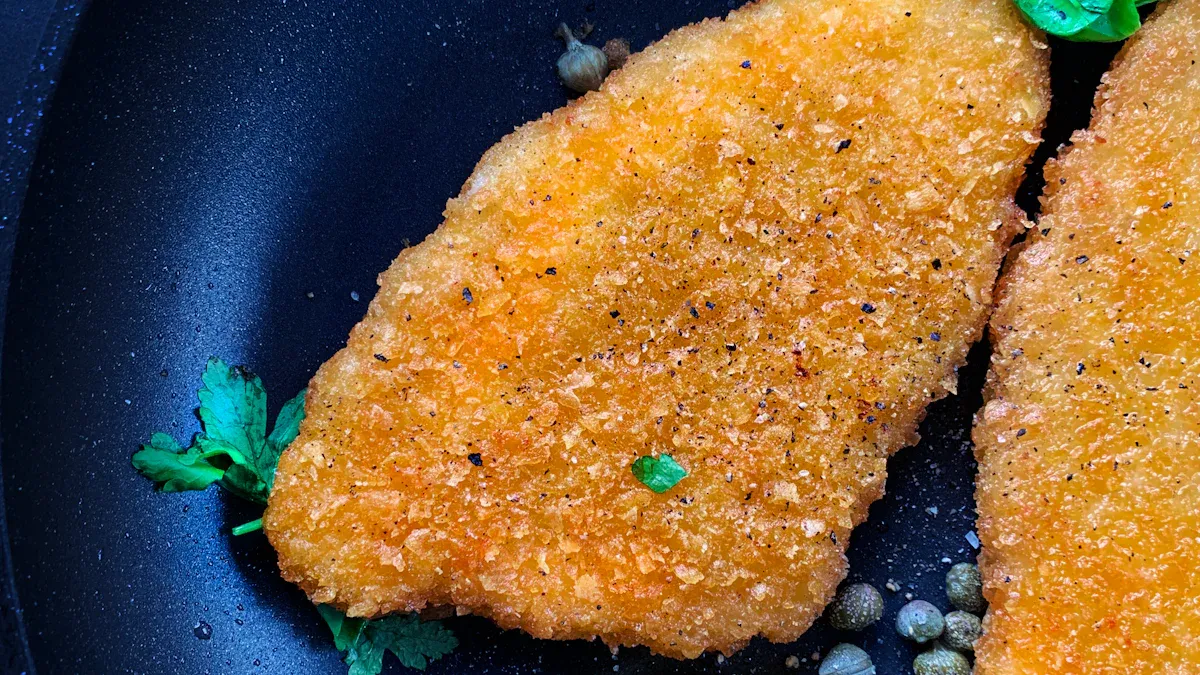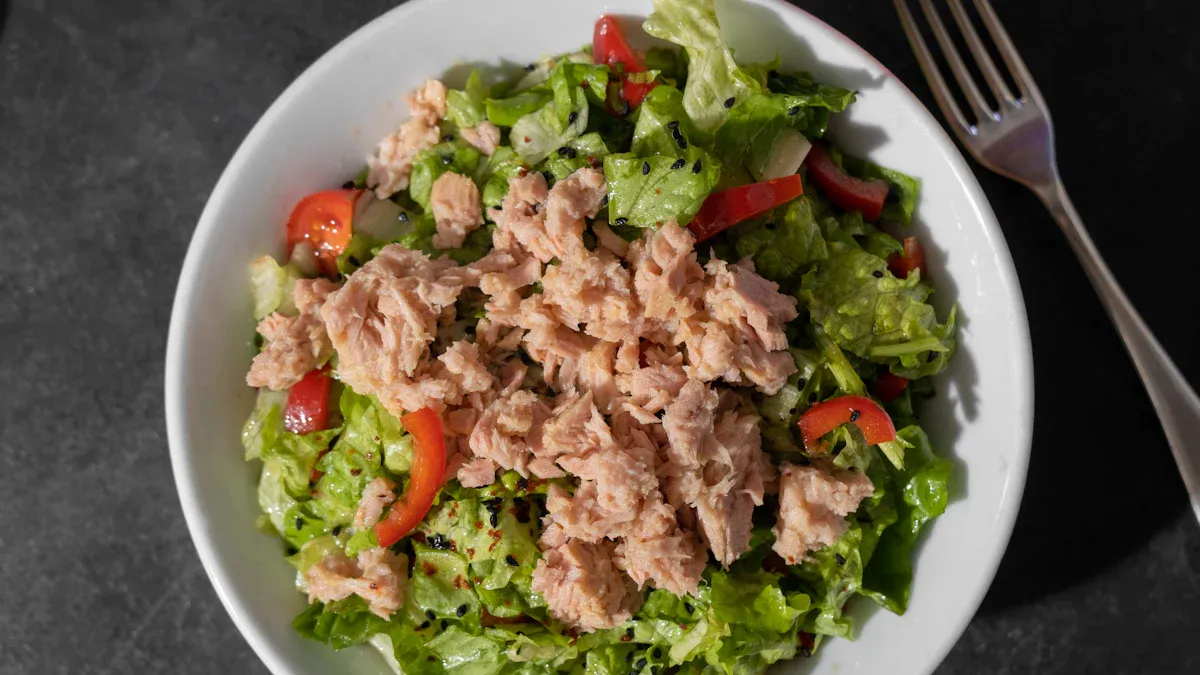Your Guide to Plant-Based Alternatives
Table of Contents

You can find excellent Plant-Based Alternatives for every seafood dish. These plant-based options range from sauces to whole shrimp. Here are some quick plant-based swaps:
- Craving oyster sauce? Use a plant-based mushroom sauce.
- Need shrimp paste? Try a plant-based fermented soybean paste.
This guide shows you the best Plant-Based Alternatives for seafood. You can master cooking with these simple plant-based ingredients.
Common Plant-Based Seafood Alternatives

You can easily replace common seafood-based sauces and broths. These plant-based seafood alternatives deliver the savory flavors you love. You just need to know which ones to choose. This section explores the best plant-based seafood alternatives for your kitchen.
Oyster Sauce
You can find excellent plant-based oyster sauce at most grocery stores. This sauce provides a deep, savory, and umami flavor. It is a perfect substitute for traditional oyster sauce. The key ingredient in these plant-based seafood alternatives is mushrooms, often shiitake. Shiitake mushrooms give the sauce its rich umami taste without any seafood.
Tip: Use plant-based oyster sauce just like the original. It works wonderfully in stir-fries, marinades, and dipping sauces. It adds a glossy finish and complex flavor to vegetable dishes.
Commercial mushroom sauces typically contain a blend of simple ingredients. You will often find the following on the label:
- Water
- Sugar or Sugar Syrup
- Soy sauce (made from soybeans and wheat)
- Salt
- Mushroom Powder or Extract
- Yeast Extract
These ingredients create a thick, rich sauce. It successfully mimics the taste and texture of traditional oyster sauce. This is one of the easiest plant-based seafood alternatives to use.
Shrimp Paste
Shrimp paste has a very strong, pungent, and salty flavor. You can replicate this unique taste with fermented soybean products. These plant-based seafood alternatives offer a similar fermented complexity.
Your two best options are:
- Miso Paste: This Japanese fermented soybean paste adds incredible depth. White miso is milder, while red miso offers a more pungent, robust flavor closer to shrimp paste.
- Fermented Bean Paste (Doubanjiang): This paste provides a deep, savory flavor. You can find spicy and non-spicy versions to suit your recipe.
Use these plant-based pastes in curries, sauces, and soups. A small amount adds a powerful savory kick. They are fantastic seafood alternatives for Southeast Asian cuisine.
Fish Sauce
Fish sauce is known for its salty, savory, and umami profile. You can find great plant-based seafood alternatives that capture this essence. Many commercial brands now offer excellent plant-based fish sauce. Brands like Ocean’s Halo use kelp, while Best of Thailand uses fermented soybeans. These products provide authentic flavor for your dishes.
The secret to great plant-based fish sauce is seaweed. Ingredients like kombu, dulse, or wakame provide a distinct “taste of the sea.” These seaweeds are often combined with:
- Soy sauce or tamari
- Mushrooms
- Miso paste
- Pineapple juice
This combination creates a complex, savory liquid. It is one of the most useful plant-based seafood alternatives for your pantry. You can use these plant-based options in dipping sauces, marinades, and soups like pho.
Clam Juice
Clam juice adds a briny, savory, and subtle oceanic flavor to dishes. You can create a convincing plant-based version at home. This is one of the most creative plant-based seafood alternatives. A simple mix of vegetable broth, seaweed, and miso paste works perfectly.
Here is how you can make your own plant-based clam juice:
- Base: Start with a simple vegetable broth.
- Ocean Flavor: Soak a sheet of nori (sushi seaweed) in hot water or broth for about 15 minutes. This adds a mild, briny taste.
- Umami Depth: Stir in a small amount of miso paste. It contributes a salty and savory richness.
This homemade broth is a wonderful plant-based substitute. Use your new plant-based clam juice in chowders, pasta sauces, and savory soups. It provides the perfect background flavor for many seafood alternatives. These plant-based alternatives are simple to make.
Whole Plant-Based Seafood Substitutes

Moving beyond sauces, you can find amazing plant-based seafood alternatives that mimic the look and feel of whole seafood. You can create everything from shrimp scampi to crab cakes using clever ingredients and techniques. These plant-based options focus on replicating texture, giving you a satisfying bite.
Shrimp
You can find excellent plant-based shrimp in many stores or make your own. Commercial products often use konjac root, which gives them a firm, bouncy texture very similar to real shrimp. King oyster mushrooms also work well. These plant-based seafood alternatives absorb marinades beautifully, making them perfect for your favorite shrimp dishes.
Your cooking technique is very important for getting a realistic texture. Proper cooking makes these plant-based seafood alternatives taste their best.
- Frying: Heat about an inch of oil in a pan. Fry the plant-based shrimp for 30-60 seconds on each side until they are golden brown. Place them on a wire rack to drain any extra oil.
- Baking: You can bake them at 400°F for about 20 minutes. Flip the shrimp halfway through the cooking time to ensure they brown evenly.
While the texture is close, the nutritional profile of konjac-based shrimp differs from conventional shrimp. Here is a simple comparison:
| Nutrient | Conventional Shrimp | Konjac-based Shrimp (Alternatives) |
|---|---|---|
| Energy | Similar | Similar |
| Fat | Similar | Similar |
| SFA | Similar | Similar |
| Carbohydrates | Lower | Significantly Higher |
| Sugar | Lower | Significantly Higher |
| Protein | Higher | Much Lower |
| Salt | Significantly Higher | Significantly Lower |
Scallops
King oyster mushrooms are the perfect plant-based seafood alternatives for scallops. The thick, meaty stem of the mushroom has a surprisingly similar texture. When you sear them correctly, they look just like real scallops.
Here is how you can turn mushroom stems into delicious plant-based scallops:
- Slice the Stems: Cut the thick stems of king oyster mushrooms into rounds about 3/4-inch thick.
- Score the Tops: Use a small knife to lightly score a diamond or crosshatch pattern into both flat sides of each round. This helps them cook evenly and absorb flavor.
- Sear Them: Heat oil in a skillet over medium-high heat. Place the mushroom “scallops” in the pan. Cook them for 2-4 minutes on each side until they are a beautiful golden-brown color.
Pro Tip: Add Oceanic Flavor 🌊 Marinate your mushroom scallops before cooking to give them a seafood-like taste. A great marinade for these plant-based seafood alternatives includes:
- Olive oil and lemon juice
- Minced garlic
- Sea salt and pepper
- Crumbled nori (seaweed) for a taste of the ocean
Crab Meat
You can easily replicate the flaky texture of crab meat using canned hearts of palm or young green jackfruit. Both are fantastic plant-based seafood alternatives for making dishes like crab cakes or crab dip. They have a neutral flavor, so they readily take on the seasonings you add.
To prepare your plant-based crab meat, you just need to break down the main ingredient.
- You can put drained hearts of palm in a food processor and pulse a few times until the texture is flaky. Be careful not to over-process them into a paste.
- Alternatively, you can place the hearts of palm in a bowl and use your hands or a potato masher to break them apart into crab-like clumps.
Tip: Perfect Your ‘Crab’ Cakes To make delicious plant-based crab cakes, you need the right binders and seasonings. These ingredients help your plant-based seafood alternatives hold together and taste amazing.
- Binders: Use vegan mayonnaise, a flax egg, or all-purpose flour.
- Seasonings: Old Bay Seasoning is essential for a classic crab cake flavor. Also add kelp flakes, fresh parsley, minced garlic, and Dijon mustard.
Lobster
You can create a convincing plant-based lobster for dishes like lobster rolls. The best ingredients for mimicking lobster’s firm, slightly chewy texture are hearts of palm and king oyster mushrooms. Hearts of palm offer a soft bite and flake nicely, while king oyster mushrooms provide a meatier feel. These plant-based seafood alternatives are perfect for soaking up a buttery, savory sauce.
Making a vegan lobster roll is simple and delicious. This recipe uses hearts of palm to create a chilled “lobster” salad that is perfect for a toasted bun. This is one of the most impressive plant-based seafood substitutes you can make.
Easy Vegan Lobster Roll Recipe 🦞
-
Ingredients for the ‘Lobster’ Mix:
- 2 cans (14 oz. each) of hearts of palm, chopped
- 1/4 cup vegan mayo
- 1 stalk celery, finely sliced
- 2 tbsp minced red onion
- 1 tsp Old Bay seasoning
- 1 tsp dried dill
- 1 tsp onion powder
- 1 tsp garlic powder
-
Instructions:
- Rinse and drain the chopped hearts of palm. Gently pat them dry.
- In a bowl, combine the hearts of palm with all the seasonings (Old Bay, dill, onion powder, garlic powder). Toss gently to coat.
- You can lightly bake or air fry the seasoned hearts of palm at 400°F for 10-15 minutes to firm them up, but this is optional. Let them cool.
- Gently mix the vegan mayo, celery, and red onion into the cooled hearts of palm.
- Spoon the plant-based mixture into a toasted, buttered bun and enjoy!
This simple approach shows how easy it is to enjoy classic dishes with plant-based seafood alternatives.
Core Ingredients in Plant-Based Alternatives
You can create amazing plant-based seafood alternatives with a few key ingredients. These core components provide the right texture and absorb flavors well. Understanding them helps you master plant-based cooking. This section explores the building blocks of great seafood alternatives.
King Oyster Mushrooms
King oyster mushrooms are a star ingredient for plant-based seafood alternatives. Their thick stems have a wonderful meaty texture. When you cook them, they become a spongy little something with a massive amount of bite. This makes them perfect for mimicking scallops or shrimp. Frying them creates a crunchy crust on the edges, while the inside stays tender.
These mushrooms are also a nutritious choice. A single cup provides important nutrients for your body.
- Niacin (Vitamin B3): Helps your cells function.
- Iron: Important for your red blood cells.
- Potassium: Supports overall health.
They are a low-calorie, high-protein option for your plant-based meals.
Konjac Root
Konjac root is a plant that gives many commercial plant-based seafood alternatives their unique texture. It is a type of water-soluble dietary fiber. This fiber creates a firm, bouncy, and slightly chewy feel. You will find it in many plant-based shrimp products. Konjac is also known for its health benefits. It can help you feel full, support digestive health, and manage blood sugar levels.
Hearts of Palm & Jackfruit
Hearts of palm and young green jackfruit are excellent for creating flaky seafood alternatives. Hearts of palm have a smoother, denser texture that holds together well, making them ideal for plant-based fish filets. Jackfruit has more of a pull-apart texture. You can shred it easily for dishes like “crab” cakes. Both ingredients have a neutral taste, so they absorb seasonings perfectly.
Quick Tip: Always rinse canned jackfruit before using it. This simple step removes the brine flavor, ensuring your plant-based dish tastes fresh.
Seaweed & Algae
Seaweed and algae are the secret to adding an authentic “taste of the sea.” They provide the briny, oceanic flavor that makes plant-based seafood alternatives so convincing.
- Kombu: This seaweed offers a deep, earthy umami flavor, perfect for broths.
- Nori: You may know this from sushi. It has a milder, slightly salty taste.
These sea plants are also packed with nutrients like iodine and antioxidants. Many commercial plant-based products blend these core ingredients with soy or pea proteins. This combination creates a complete texture and makes for delicious plant-based seafood alternatives.
Your Plant-Based Shopping Guide
Finding great plant-based seafood alternatives is easier than ever. You just need to know what to look for and where to go. This guide will help you navigate the store with confidence. You can find delicious plant-based options for any meal.
What to Look For
You should always read product labels carefully. Many plant-based products contain common allergens. The FDA requires labels to list the eight major food allergens, which include soy, wheat, and shellfish. You can find this information in a “Contains” statement right after the ingredient list.
Allergen Alert ⚠️ Some reports show that certain plant-based seafood alternatives fail to declare allergens like soy or wheat. Always double-check the label if you have food sensitivities. This ensures your plant-based choices are safe for you.
Where to Shop
You can find plant-based seafood alternatives in most grocery stores. Check these common sections:
- The International Foods Aisle (for sauces and pastes)
- The Health Food Section
- The refrigerated plant-based area near the tofu
Online stores also offer a huge selection. Retailers like Vegan Essentials provide a diverse range of plant-based seafood alternatives. They carry over a dozen different products, from plant-based tuna to shrimp. Shopping online is a great way to explore new plant-based brands.
Key Brands
When you start your search, some brands are known for quality. If you need a great plant-based oyster or fish sauce, look for these names. They offer excellent flavor for your recipes. These brands make some of the best plant-based seafood alternatives for your pantry.
- 24Vegan: This brand makes a non-GMO vegan oyster sauce and fish sauce.
- Lucky Foods: You can find a popular vegan oyster sauce from this brand.
- Wan Ja Shan: This company offers a vegetarian mushroom oyster sauce that is also vegan.
- Sprouts: The store’s own brand has an affordable plant-based oyster-style sauce.
These trusted brands make it simple to switch to delicious plant-based alternatives.
You can easily enjoy delicious plant-based meals. The right plant-based ingredients make replacing shellfish simple. You can make amazing plant-based scallops from king oyster mushrooms. This is one of the easiest plant-based swaps. These plant-based alternatives are delicious.
Try this simple swap! 🧑🍳 Use a plant-based oyster sauce in your next stir-fry. You will taste the difference!
FAQ
Are plant-based seafood alternatives healthy?
Yes, they can be a healthy choice. These alternatives are free of cholesterol. Many options, like those made from konjac root or mushrooms, provide fiber. You should always check the nutrition label for specific details on sodium and protein content.
Can I make these alternatives at home?
You can easily make many seafood alternatives yourself. You can sear king oyster mushroom stems to create amazing scallops. You can also shred hearts of palm to make delicious plant-based ‘crab’ cakes right in your own kitchen.
Do plant-based options taste exactly like real seafood?
Plant-based substitutes focus on matching texture. The oceanic flavor comes from the seasonings you add. Ingredients like seaweed, miso, and Old Bay seasoning help you create that classic seafood taste you enjoy.
What is the easiest way to start? 💡
You can begin with a simple sauce swap. Try replacing regular oyster sauce with a mushroom-based version in your next stir-fry. This easy change lets you experience the great taste of plant-based alternatives without learning a new recipe.

Poseidon
Master of Nutritional Epidemiology, University of Copenhagen, Herbal Functional Nutrition Researcher
Focus: The scientific application of natural active ingredients such as Tongo Ali, Horny Goat Weed, and Maca to sexual health and metabolic regulation.
Core Focus:
Men: Use a combination of Tongo Ali (an energizing factor) + Maca (an energy reserve) to improve low energy and fluctuating libido.
Women: Use a combination of Horny Goat Weed (a gentle regulator) + Maca (a nutritional synergist) to alleviate low libido and hormonal imbalances.
Stressed/Middle-Aged Adults: This triple-ingredient synergy supports metabolism, physical strength, and intimacy.
Product Concept:
Based on traditional applications and modern research (e.g., Tongo Ali promotes testosterone-enhancing enzyme activity, and icariin provides gentle regulation), we preserve core active ingredients and eschew conceptual packaging—using natural ingredients to address specific needs.
Simply put: I'm a nutritionist who understands "herbal actives." I use scientifically proven ingredients like Tongo Ali, Epimedium, and Maca to help you make "sexual health" and "nutritional support" a daily routine.
